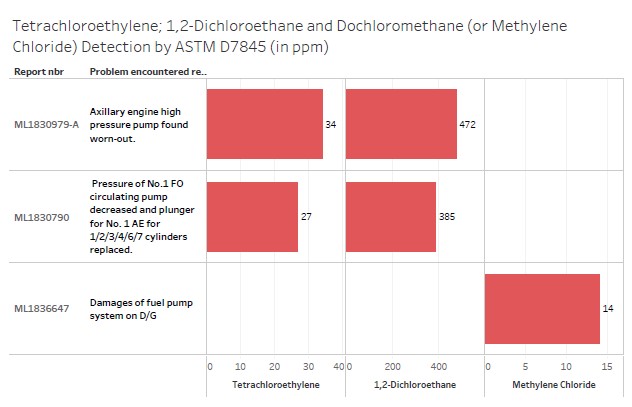News & Events
Related Pages
Maritec Offers Basic Chemical Species Analysis
by ASTM D7845 GCMS
Newsletter on 20 Aug,2021
ASTM D7845 GCMS is an international standard test method, recognised internationally by bunker claim companies, P&I clubs and local Maritime Port of Authorities, for quantifying chemical species in bunker fuels.
The current ISO 8217 specification covers physical characteristics and elemental content of bunker fuels. Maritec basic chemical species analysis by ASTM D7845 can complement the ISO 8217 specification and enhance the protection for vessels.
The chemical screening by GCMS Headspace technique is the typical testing regime by bunker testing laboratories. We have a few hundred vessels register with Maritec Fuel Testing Program already subscribe to this chemical screening.
With effect from 20-Aug-2021, Maritec will replace the chemical screening method from GCMS Headspace to ASTM D7845 method. The switchover to ASTM D7845 enhances the testing value offered by Maritec as this is the only GCMS technique developed with an international standard and with ISO8217/PAS reference. These 2 reference standards are useful in managing bunker claims effectively under ISO8217 clause 5. Maritec R&D Laboratory offers an extensive forensic analysis on investigation bunker quality issues beyond GCMS ASTMD D7845 to support customers in our testing programme.
A brief explanation on the GCMS ASTM D7845 technique and investigation methodology on chemical species as follows:
ASTM D7845 GCMS is a direct liquid injection GCMS technique in which a small portion of the whole sample is diluted in solvent and the sample solution is injected into GCMS for analysis. ASTM D7845 technique is capable of quantifying volatile to semi-volatile compounds such as chlorinated solvents, slightly reactive hydrocarbons with double bond (C=C), phenolic compounds and fatty acids methyl esters (FAMEs). Sample loss is minimised during sample preparation stage for ASTM D7845 technique when compared to head-space GCMS where only the volatile fractions is transferred to GCMS for analysis. However, ASTM D7845 technique is unable to detect polar and high boiling point compounds such as fatty acids, rosin acids, alkylresorcinols, bisphenols and others. These polar and high boiling point compounds can be detected using Maritec GCMS by Solid Phase Extraction (SPE) technique.
Table 1: Basic Chemical Species Analysis by ASTM D7845 GCMS
| No | Volatile Organic Compounds | CAS No. | Compound Group | Significance of Analysis |
| 1 | Dichloromethane | 75-09-2 | Chlorinated Organic Compound (non-hydrocarbon) | Indication for the presence of residual chlorinated degreasing/cleaning solvents in bunker fuel, usually associated with fuel injection pump problems |
| 2 | 1,2-dichloroethane | 107-06-2 | ||
| 3 | Tetrachloroethylene | 127-18-4 | ||
| 4 | Phenol | 108-95-2 | Phenolic Compound (non-hydrocarbon) | Indication for the presence of other phenolic compounds and alkylresorcinols (components of Estonian shale oil) in bunker fuel, usually associated with purifier sludging and filter clogging problems |
| 5 | Styrene | 100-42-5 | Hydrocarbon Compound | Indication for the presence of residue components of steam cracking in bunker fuel, at high concentration, usually associated with purifier sludging and filter clogging problems |
| 6 | Dicyclopentadiene | 77-73-6 | ||
| 7 | Dihydro-dicyclopentadiene | 4488-57-7 | ||
| 8 | Indene | 95-13-6 | ||
| 9 | Butanol | 71-36-3 | Alcohol (non-hydrocarbon) | Indication for the presence of tall oil in bunker fuel, usually associated with fuel injection pump problems, if fatty acids and rosin acids are further detected by SPE GCMS |
| 10 | Alpha-pinene | 80-56-8 | Hydrocarbon Compound |
Figures 1A and 1B give the instances from Maritec’s ASTM D7845 database where the chemical species such as phenol, indene, dicyclopentadiene, styrene, dihydro-dicyclopentadiene, tetrachloroethylene, 1,2-dichloroethane and dichloromethane (or methylene chloride) were detected and problems were encountered on-board vessels.


Phenol is an indicator to show that a fuel may contain other phenolic compounds and phenethyl alcohols. If a fuel is detected with the presence of phenol, it is highly recommended that vessels shall proceed full ASTM D7845 GCMS analysis to detect presence of other phenolic compounds and phenethyl alcohols.
If both butanol and alpha-pinene are detected in a fuel sample, this is an indication that the particular fuel may contain fatty acids and rosin acids which are originated from tall oil. Further GCMS by solid phase extraction (SPE) analysis is recommended to quantify the amount of fatty acids and rosin acids if present.
Maritec has been generating database on chemical species in bunker fuel and their associated problems on machinery. By knowing the chemical species present in the bunker fuels and their associated problems on machinery, vessel can exercise precautionary steps and optimise the operation to avoid and reduce the anticipated problems.
If high concentration of the detected chemical species are non-hydrocarbon by nature and the vessel also reported machinery damages, these are evidence that the fuel is contravening clause 5 of ISO 8217. Vessels can engage P&I clubs to handle bunker claims and gather these facts and evidence to negotiate with bunker supplier or the relevant parties for a claim on the loss incurred.
More information on Maritec’s accredited GCMS analysis technique used to detect chemical species in bunker fuels and their associated problems on machinery can be found in the Newsletter published earlier by Maritec.
Get in touch
If you have any questions or comments please don't hesitate to contact us
Services
Fuel Testing Solutions Water Compliance Services IHM & Recycling Asbestos Management Solutions NDT&UTMContact Us
192 Pandan Loop,
#05-27 Pantech Business Hub,
Singapore 128381
T +65 6271 8622